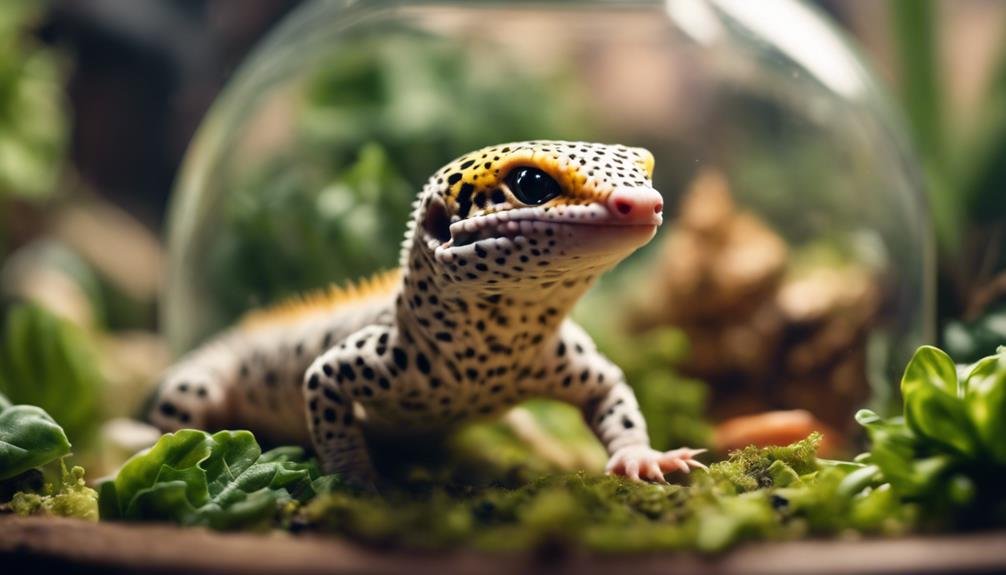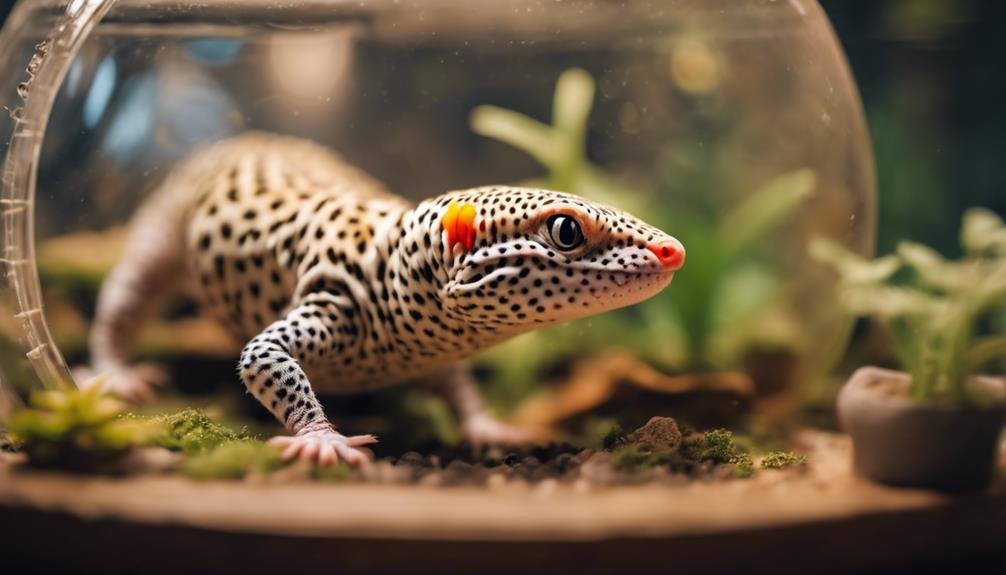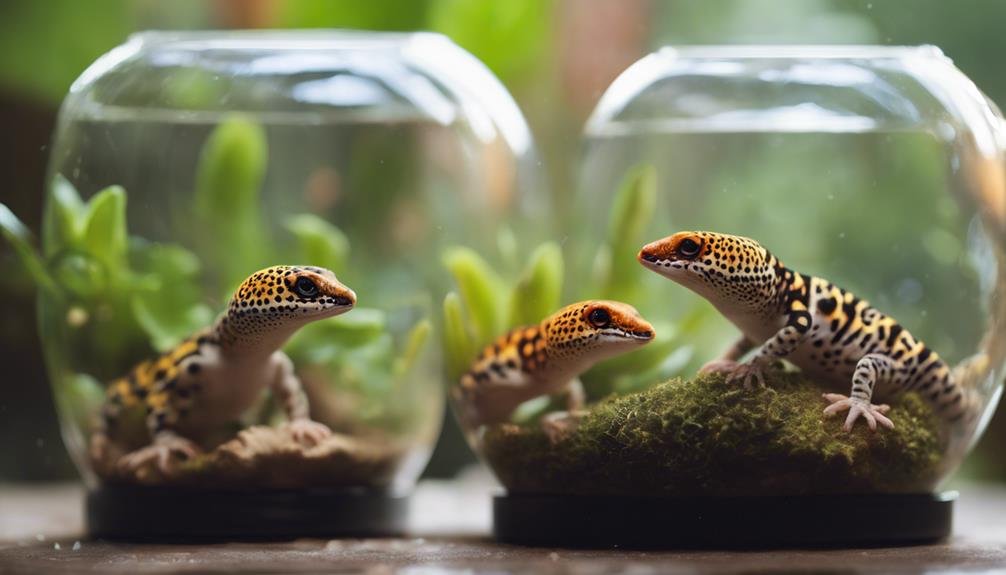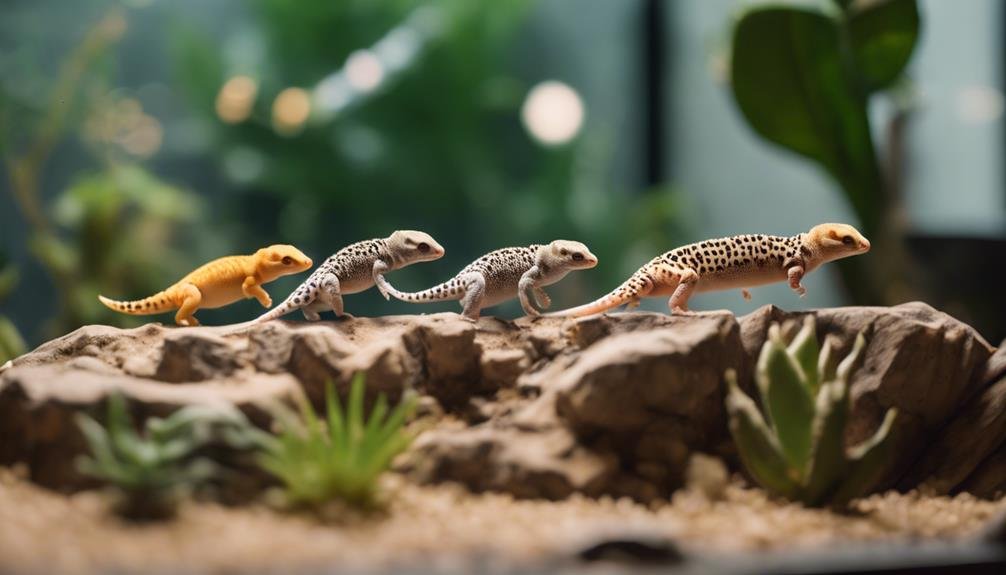If you’re considering a leopard gecko as a pet, you might be wondering just how long you can expect your new companion to stick around. While it’s commonly known that these reptiles can live well into their teens with proper care, there are instances of leopard geckos reaching the ripe old age of 20 or even 30 years under exceptional circumstances. However, several lesser-known factors can greatly influence their lifespan, from the quality of their diet to the subtleties of their environmental setup. Curious about what it takes to maximize the life of your leopard gecko? Let’s explore how you can potentially double their life expectancy.
Key Takeaways
- Leopard geckos typically live 10-20 years in captivity, and potentially up to 40 years.
- In the wild, their lifespan is usually between 3-8 years.
- Captive environments with controlled diet, habitat, and care extend their lifespan.
- Factors like genetics, diet quality, and habitat conditions significantly affect their longevity.
- Regular veterinary care and proper environmental maintenance are crucial for a longer, healthier life.
Leopard Gecko Lifespan Overview
Leopard geckos in captivity usually live between 10 to 20 years, although some may reach the age of 40 with excellent care. This impressive lifespan is largely due to factors like diet, habitat quality, and genetics, which you can control to make sure your pet thrives. Providing a well-balanced diet rich in essential nutrients is vital. It’s not just about offering the right foods; it’s about providing the right amounts at the right stages of their life.
You’ll also need to mimic their natural habitat as closely as possible. This means maintaining appropriate temperature gradients, humidity levels, and providing hiding spots to reduce stress. Regular veterinary care plays a pivotal role in catching and addressing health conditions early on, which can greatly extend their lifespan.
Life in the Wild Vs Captivity
Comparing the lives of leopard geckos in the wild to those in captivity reveals notable differences in lifespan and daily challenges. In the wild, leopard geckos have a tougher time due to harsh conditions and the presence of natural predators, which greatly shortens their lifespan to about 3-8 years. Conversely, in captivity, these geckos enjoy a more controlled environment which enhances their longevity, allowing them to live between 10-20 years.
You’ll notice that captive leopard geckos benefit greatly from proper care and nutrition, factors absent in their natural habitat. This care includes regular veterinary attention and a steady, parasite-free diet, ensuring they live longer and healthier lives. Here’s a quick comparison:
| Aspect | In the Wild | In Captivity |
|---|---|---|
| Lifespan | 3-8 years | 10-20 years |
| Environment | Harsh conditions | Controlled environment |
| Challenges | Natural predators | Mostly absent |
| Health Care | Minimal | Regular veterinary care |
| Nutrition | Unpredictable | Balanced and monitored |
Understanding these differences helps you appreciate how captivity can sometimes be a sanctuary from the brutal realities of the wild.
Dietary Impact on Lifespan


A proper diet greatly extends the lifespan of your leopard gecko, guaranteeing they receive all essential nutrients. It’s important to provide a varied diet, which should include a mix of insects like crickets and mealworms, each rich in important nutrients. To enhance their nutritional intake, you should gut-load these insects with nutritious feeds 24 to 48 hours before feeding time. This prep stage ensures that your gecko isn’t just filling up on empty calories.
Moreover, it’s significant to dust these insects with calcium and vitamin supplements. This step is crucial as it prevents nutritional deficiencies that can lead to serious health issues and potentially shorten your gecko’s life. Remember, the size of the insects shouldn’t be larger than the space between your gecko’s eyes to avoid digestive issues and support a healthy diet.
Always make sure fresh water is available in your gecko’s enclosure. Hydration plays a critical role in their overall health and can influence their lifespan positively. By focusing on these dietary needs, you’re setting up your leopard gecko for a longer, healthier life. Stick to these guidelines, and you’ll maximize their wellbeing and longevity.
Habitat and Environmental Needs
To guarantee your leopard gecko thrives, it is essential to maintain a hot spot in their tank at 90-95 degrees Fahrenheit for proper thermoregulation. In addition to the hot spot, you’ll want to keep the ambient temperature around 80 degrees Fahrenheit. This temperature gradient allows your gecko to regulate its body temperature by moving between warmer and cooler areas.
Leopard geckos also need specific humidity levels to stay healthy. Aim to maintain humidity around 30-40% to help with shedding and overall health. As for their living space, young geckos do well in a 20-gallon tank, but as they grow, they’ll need a 40-50 gallon tank to explore and exercise.
Remember, the setup of their habitat is key. Include plenty of hiding spots and enriching decor to simulate a natural environment. Here’s a quick guide to setting up your leopard gecko’s habitat:
| Requirement | Young Gecko | Adult Gecko |
|---|---|---|
| Tank Size | 20 gallons | 40-50 gallons |
| Humidity | 30-40% | 30-40% |
| Hot Spot Temp. | 90-95°F | 90-95°F |
| Ambient Temp. | 80°F | 80°F |
| Decor | Enriching & Hiding | Enriching & Hiding |
Proper gecko care, including UVB lighting and proper nutrition, further ensures your leopard gecko’s longevity and vitality.
Common Health Issues


While ensuring the proper habitat is essential for your leopard gecko, it’s also important to be aware of common health issues that can affect their well-being. Here are a few critical conditions you should watch out for:
- Metabolic Bone Disease (MBD): This condition stems from calcium deficiency and inadequate vitamin D, leading to weakened bones, seizures, and even death if untreated.
- Respiratory Disease: Often caused by bacterial lung infections, this issue can result from too much humidity and the presence of mold in the enclosure, making it vital to maintain the right environmental conditions.
- Retained Shed: Due to low humidity, your gecko might experience incomplete skin shedding. This can lead to circulation issues in the affected area if not promptly resolved.
Additionally, Vitamin A Deficiency can make your gecko’s skin dull and cause mucus buildup around the eyes. Ensuring a diet rich in varied insects such as silkworms and cockroaches can help prevent this. Egg Binding, another significant concern, particularly in female geckos, can occur from stress or poor nutrition. It highlights the importance of a well-maintained and stimulating environment for preventing such reproductive issues.
Preventative Care Strategies
Implementing regular veterinary exams and maintaining ideal habitat conditions are essential steps in preventing health issues in your leopard gecko. Ensuring your gecko’s environment is perfectly set up can greatly increase its average lifespan. You should provide fresh water daily and manage the terrarium’s temperature and humidity closely. Lighting for 10-12 hours a day helps mimic their natural environment, which is essential for their health.
A balanced diet of insects is important. This not only prevents malnutrition but also wards off bone disease, a common ailment in captive geckos. Regular habitat cleaning is another key aspect. Remove waste and uneaten food promptly to prevent the growth of mold and bacteria, which can severely impact your gecko’s health.
Pay attention to any signs of illness, such as lethargy, loss of appetite, or unusual behavior, and consult your vet immediately if you notice anything amiss. These preventative care strategies contribute significantly to extending the leopard geckos lifespan, ensuring they live a full and healthy life. Remember, the care you provide directly influences your gecko’s well-being and longevity.
Breeding and Lifespan


Understanding how breeding impacts the health and longevity of leopard geckos is important as they can live up to 20 years under ideal conditions. When you consider breeding your pet geckos, it’s vital to recognize not just the commitment but also the possible strain it places on the females. Repeated breeding can be stressful, especially if it results in the laying of infertile eggs, which may detrimentally affect their health and shorten their lifespan.
Here are important considerations for maintaining the health and longevity of breeding leopard geckos:
- Sexual Maturity: Leopard geckos typically reach sexual maturity between 9 and 18 months. Breeding them too early or too frequently can lead to health complications.
- Captive Conditions: Good captive conditions, including controlled environments that reduce disease risks, greatly contribute to their longevity.
- Veterinary Care: Regular check-ups and access to exotic veterinary care are essential, especially for breeding geckos, to make sure any health issues are promptly addressed.
In captivity, leopard geckos can enjoy a long life if cared for properly. The average lifespan ranges from 10 to 20 years, highlighting the effectiveness of good captive care. As you explore breeding and lifespan, always prioritize the well-being of your geckos to guarantee they live the fullest years in captivity.
What Factors Contribute to the Lifespan of Different Gecko Species?
The crested geckos lifespan and longevity can be influenced by factors such as genetics, diet, habitat, and temperature. Providing a well-balanced diet, a suitable environment, and regular veterinary care can contribute to a healthier and longer lifespan for different gecko species, including crested geckos.
Lifespan Enhancement Tips
To maximize your leopard gecko’s lifespan, make sure to schedule regular veterinary exams and provide appropriate terrarium conditions. Regular check-ups are important, as veterinarians can detect and treat potential health issues early, greatly enhancing longevity.
Proper care involves meticulous habitat maintenance. You’ll need to know how to balance the terrarium’s temperature, humidity, and lighting, including UVB exposure, to mimic their natural environment. This not only promotes better health but also aids in metabolic processing and stress reduction. Make sure that the heating elements are safe and can’t burn your gecko, as burns can severely impact their health and lifespan.
Nutrition is another essential aspect. Offer a varied diet rich in essential nutrients, which helps prevent nutritional deficiencies and supports a longer life. Establishing a consistent feeding schedule also plays a significant role in maintaining good health.
Lastly, don’t overlook the importance of regular habitat cleaning and observing your gecko for any signs of illness. Keeping their living space clean and monitoring their behavior and physical condition are key practices for preventing disease and extending your leopard gecko’s average lifespan. By following these guidelines, you can ensure your leopard gecko thrives for years to come.
Conclusion
You’ve learned that leopard geckos can live up to 20 years in captivity, even reaching 40 with exceptional care. To maximize their lifespan, make sure they’ve a balanced diet, ideal habitat conditions, and regular vet visits.
Addressing health issues promptly and implementing preventive care strategies are essential. By understanding their needs and providing diligent care, you can help your leopard gecko lead a long, healthy life.
Remember, their well-being is in your hands!


